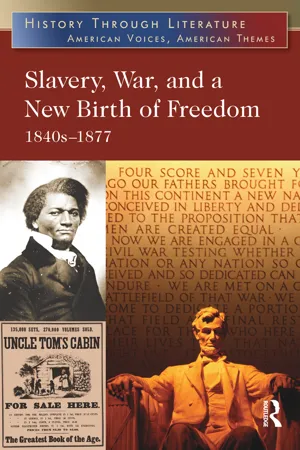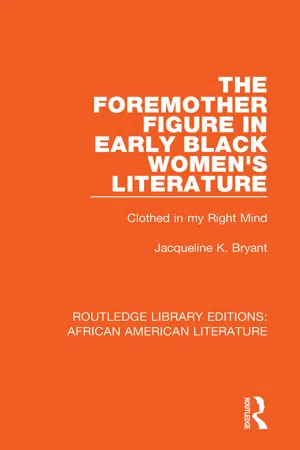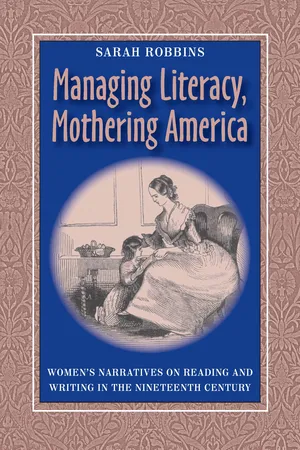History
Harriet Beecher Stowe
Harriet Beecher Stowe was an influential American author and abolitionist known for her novel "Uncle Tom's Cabin," which depicted the harsh realities of slavery and played a significant role in shaping public opinion on the issue. Her work sparked widespread debate and activism, contributing to the growing anti-slavery movement in the United States during the 19th century.
Written by Perlego with AI-assistance
Related key terms
Related key terms
1 of 4
Related key terms
1 of 3
6 Key excerpts on "Harriet Beecher Stowe"
- eBook - ePub
Slavery, War, and a New Birth of Freedom
1840s-1877
- Jeffrey H. Hacker(Author)
- 2014(Publication Date)
- Routledge(Publisher)
Stowe, Harriet Beecher (1811–1896)Author and activist Harriet Beecher Stowe is best known for her powerful antislavery novel Uncle Tom's Cabin (1852), an enormously popular work that gave millions of Americans their first view of the slave experience through the eyes of those in bondage. The book and stage adaptation changed the popular perception of slavery energized the abolitionist movement, and pushed the nation closer to civil war.She was born Harriet Elizabeth Beecher on June 14, 1811, in Litchfield, Connecticut. Her father, Lyman Beecher, was a renowned Presbyterian minister as well as an activist for the temperance and abolitionist causes. Her mother, Roxana Foote Beecher, died when Harriet was 5 years old. Many of the Beecher children achieved prominence, among them Harriet’s sister Catharine Beecher, a noted educator; brothers Henry Ward Beecher and Charles Beecher, both Congregationalist ministers and social reformers active in the abolitionist movement; and sister Isabella Beecher Hooker, a leader in the woman suffrage movement. Harriet studied and later taught at Hartford Female Seminary, which was founded and operated by her sister Catharine. In 1832, her father accepted the presidency of Lane Theological Seminary, and the family moved to Cincinnati, Ohio. There, Harriet met and married Calvin Stowe, a minister and professor at Lane.Six of the Stowes’ seven children were born during their years in Cincinnati. It also was during this time that slavery became more than an abstract concept for the Beecher family. Although Lyman Beecher had preached against slavery throughout his career, living just across the Ohio River from the slave state of Kentucky gave Harriet and the rest of the family firsthand experience with the institution. The Beechers grew even more vocal in their opposition to slavery and became active in the Underground Railroad. - eBook - ePub
A Nation Divided
Ten Portraits of Those Who Formed It
- Paul D. Escott(Author)
- 2023(Publication Date)
- University of Virginia Press(Publisher)
wrong of slavery was not matched by a sense of urgency toward the solution.Harriet Beecher Stowe stands out due to her immense influence on the North’s encounter with the slavery issue. Her lecture tour of England in 1853 also advanced antislavery activities there. She was the agent of significant change in the feelings of many individuals, a reformer who mattered. Although she spoke out in 1869 for greater legal rights for married women, Uncle Tom’s Cabin was her greatest achievement. Despite carrying racist attitudes whose grip on American society should not be underestimated, Stowe aroused potent antislavery emotions among formerly indifferent citizens. Through her work northerners grew more concerned about slavery’s impact on the nation and listened more attentively to Free Soil or Republican parties. That was a vital contribution to change, for politicians generally were responding to citizens’ concerns rather than initiating action on their own.To reach her audience, Stowe drew on her own maternal instincts, on her religious convictions, and on the heritage of the Great Awakenings, and she invented a narrative that could prod society toward reform. Her novel brought the hopes and dreams, the suffering and pain, of slaves to life. It humanized millions of Black people for white readers who had considered the enslaved—when they thought of them at all—only abstractly as strange and inferior beings involved in a distant and different system. To be sure, northerners also had economic and political reasons to be alarmed over slavery’s demands, and those could prove more important than morality. But it is difficult to explain the growth of antislavery attitudes in the North of the 1850s without the awakening of the religious and humanitarian concerns that Stowe shared and stimulated. - eBook - ePub
Golden Cables of Sympathy
The Transatlantic Sources of Nineteenth-Century Feminism
- Margaret H. McFadden(Author)
- 2021(Publication Date)
- The University Press of Kentucky(Publisher)
I should think that the Sphinx in the London Museum might have sat for most of them” (Life, 231). Harriet Beecher Stowe, courtesy of the Harriet Beecher Stowe Center, Hartford, Connecticut. On her second voyage to Europe, in 1856, she was still plagued by body-image discussions, writing to her husband from Paris on November 7: “As usual, my horrid pictures do me a service, and people seem relieved when they see me; think me even handsome ‘in a manner.’ Kingsley, in his relief, expressed as much to his wife, and as beauty has never been one of my strong points I am open to flattery upon it” (Life, 288). Even Frances Power Cobbe, when they met in Italy, commented that Stowe “struck me as a woman who had been completely stared out of countenance. . . . [She] seems to have been looked at till she could no longer venture to open her eyelids quite comfortably.” 12 In Paris the Beecher-Stowe party not only sat for portraits by Hilaire Belloc (husband of Stowe’s translator) but also took advantage of the new daguerreotype technology to have impressions made (Beecher, 322–23). Had photography been slightly more advanced at the time Uncle Toms Cabin was published, Harriet might not have had so many curious onlookers. Stowe and the International Reformist Network A significant international network of reform-minded persons predated Stowe’s journeys, but she added immensely to its density and strength. Ideas of female emancipation were already part of the manifold conversations out of which the network was formed, and even though she her self was no champion of women’s rights, Stowe nevertheless contributed to that cause. The crusading vision that had produced Uncle Tom’s Cabin, her willingness to travel the world on behalf of antislavery, and her way of magnetically drawing a variety of influential people to herself and her movement—these ineluctably created a new image of what was possible for females - Elena V. Shabliy, Dmitry Kurochkin, O’Donnell Karen(Authors)
- 2018(Publication Date)
- Routledge(Publisher)
Fin de Siècle Women Writers Afrin ZeenatMid-century white women writers participated in nation building by writing novels of social reform that advocated assimilation rather than racial exclusion of their colored brothers and sisters.1 Among them, Harriet Beecher Stowe’s Uncle Tom’s Cabin (1852) was successful as an antislavery novel that also blends elements of the orphan girl story. Its cultural prominence in the fin de siècle is evident from the different literary imitations of some of its tropes, mainly its message of social reform. Mimicking Stowe, some women writers of color in the fin de siècle , too, wrote in order to participate in national affairs, seek inclusion, and advocate social change. Specifically, Mrs. Amelia E. Johnson’s Clarence and Corinne, or, God’s Way (1890) and Helen Hunt Jackson’s Ramona (1884) both borrow and rewrite the discourse of Stowe’s Uncle Tom’s Cabin .2 Since “discourse is by its very nature dialogic,” for Mikhail Bakhtin the practice of “appropriating another’s discourse” could reveal a “whole spectrum of possible relationships” with that discourse, from its reverent use to a parody.3 By appropriating Stowe and the discourse of the mid-century sentimental women writers, their literary predecessors, Johnson and Jackson, reverently mimic their discourse of racial uplift and also offer its subtle parody. Literary heteroglossia enables Johnson and Jackson to present a whole spectrum of worldviews about the racial orphan (immortalized by Stowe’s portrayal of Topsy) from the dominant worldview, which occludes racial orphans from civil society, to those who sympathize and help them assimilate in American society. Through the deployment of race erasure and a good Christian character of their protagonists, these writers rewrite the classic orphan girl stories to bring about social change in America.The role of women, both married and single, was reenvisioned in the 19th century. As the main producers and consumers of novels, women became the main focus of 19th-century writers, both male and female. Some writers, mostly male, propagated the cults of republican motherhood and single blessedness that placed domestic responsibilities on women, while positioning men in the outdoors.4 On the other hand, women writers reacted by writing sentimental romances which gained popularity in the period, especially in the latter half of the century, and were highly resented by male writers like Nathaniel Hawthorne (1804–1864), who referred to them as “the damned mob of scribbling women.”5- eBook - ePub
The Foremother Figure in Early Black Women's Literature
Clothed in my Right Mind
- Jacqueline K. Bryant(Author)
- 2018(Publication Date)
- Routledge(Publisher)
She occupies a place in the white household but not the integral position that she was portrayed to have held during the middle of the nineteenth century. Yet, she remains. AUNT CHLOE, AUNT DINAH AND MAMMY IN UNCLE TOM’S CABIN Harriet Beecher Stowe’s Uncle Tom’s Cabin (1852) inscribes three mammy figures whose correlation with the white female results in characterizations reflected in forms of work and responsibility. Christian says of Stowe’s characterization that the Negro is a dramatic focal character rather than a comic minor character (1980, 21) because feminine qualities are assigned to both male and female Negro characters. Abolitionists viewed these feminine qualities as superior rather than inferior because these were humane qualities that many whites lacked. Based on a first reading and Christian’s seemingly positive criticism, one could locate the writer in abolitionism and easily disregard other significant factors associated with this dramatic focal characterization. Christian reveals, however, that this quality of feminization parallels servility; thus dramatic focal characterization is not necessarily a superior or positive character portrayal, but fitting for the Negro, whether male or female. Similar to Christian, Ducksworth finds that the author’s antislavery sentiments, though full of righteous condemnation, lack notions of racial equality (1994, 205), even though religion, which assumes spiritual egalitarianism, is used as a motif for her message of sympathy. Such contradictions of course, are not unusual among white abolitionists. Yarborough, too, finds that although Stowe sympathized with the slave, her commitment to challenging the claim of black inferiority was undermined by her own endorsement of racial stereotypes (1986, 47) - eBook - ePub
Composition, Literacy, and Culture
Women's Narratives on Reading and Writing in the Nineteenth Century
- Sarah Robbins(Author)
- 2009(Publication Date)
- University of Pittsburgh Press(Publisher)
36 Similarly, Stowe’s white women readers would have been able to identify with his indirect exercise of influence over Augustine St. Clare and the slave community at Legree’s plantation through literacy-based learning from George and Eva. But basing Tom’s claim to social agency in this highly gendered model also paved the way for future representations of his character (e.g., in plays, illustrations, and statuettes) as weak at best—particularly since the efficacious aspects of the feminized literacy manager role became less familiar to American readers over time, as domestic literacy narratives’ discursive patterns and ideology faded from cultural memory.Perhaps one way to help today’s readers access Uncle Tom’s Cabin in its own cultural context is to expand our focus beyond Tom to other characters marked by Stowe’s adoption of the domestic literacy narrative. One of these is Mrs. Shelby, on stage for brief periods but ideologically significant, given the novel’s generic heritage. Working indirectly through her son George, Mrs. Shelby can be seen as another of Tom’s motherly teachers and, like Tom, a motherly teacher for the reader. Also like Tom, Mrs. Shelby is quite limited in her own access to social agency and must stake her best hope for a more moral society in the “rising generation” represented by George. As Stowe explains in her Key, although technically a member of the plantation class, Mrs. Shelby tries to resist its misplaced values. Stowe pointedly credits her commitment to morality-linked education, to the extent possible in a constrained situation. And just in case the novel’s first audience had missed the sympathetic components of the character, Stowe describes Mrs. Shelby in the Key asof the very best class of Southern women; and while the evils of the institution [of slavery] are felt and deplored, and while the world looks with just indignation on the national support and patronage which is given to it, and on the men who . . . deliberately make efforts to perpetuate and extend it, it is but justice . . . [to] bear in mind the virtues of such persons. Many of them, surrounded by circumstances over which they can have no control, perplexed by domestic cares of which women in free states can have very little conception, loaded down by duties and responsibilities which wear upon the very springs of life, still go on bravely and patiently from day to day, doing all they can to alleviate what they cannot prevent and, as far as the sphere of their own immediate power extends, rescuing those who are dependent upon them from the evils of the system. (12)
Index pages curate the most relevant extracts from our library of academic textbooks. They’ve been created using an in-house natural language model (NLM), each adding context and meaning to key research topics.
Explore more topic indexes
Explore more topic indexes
1 of 6
Explore more topic indexes
1 of 4





